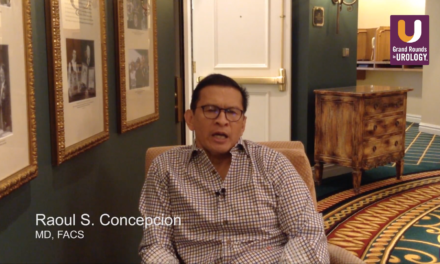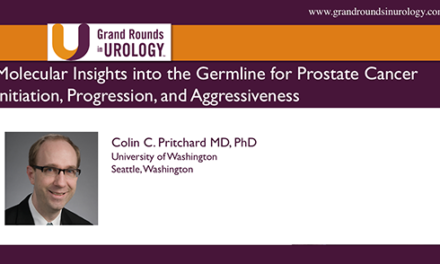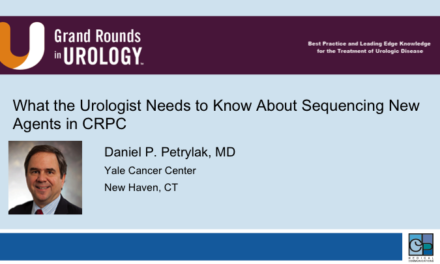This is presentation two of five of the CME accredited program, “The Multidisciplinary Approach to Treating Prostate Cancer Using Radiopharmaceuticals.” Please complete all lectures before clicking on “CME Post-Test.”
Keywords: prostate cancer, radium-223, ALSYMPCA, abiraterone
How to cite: Shore, Neal. “Radiopharmaceuticals : Has There Been Progress?” Grand Rounds in Urology. January 23, 2016. Dec 2024. https://dev.grandroundsinurology.com/prostate-cancer-neal-shore-radiopharmaceuticals-has-there-been-progress/.
CME POST-TEST
Thank you for participating in the CME activity.
For CME credit, visit Medical College of Wisconsin. Immediately upon passing the online test, you will receive your certificate via email.
Transcript:
Radiopharmaceuticals: Has There Been Progress?
Like other radiopharmaceuticals strontium, samarium, radium-223 is ideally prescribed after patient has progressed on taxane based chemotherapy. I would say you know it’s clearly approved in both settings and I’m going to review now why I think it’s really ideally suited prior to chemotherapy. So where is the actual place for radium-223 in the ALSYMPCA trial, which I’ll review in a minute. We know it was patients could’ve received and been accrued to the trial if they had received chemotherapy or they refused chemotherapy or were deemed unfit for chemotherapy. This is a different sort of spin looking at this curve were patients some have PSA relapse. They start novel hormonal therapies potentially and when they’re in the M1 CRPC population. So they could be on Abi or Enza this point.
As we know in more and more literature on splice variants there are patients who will develop in a small subset primary resistance and eventually invariably all develop some level of acquired resistance. So what’s happening during that time when the PSA is starting to rise and particularly in a patient with bone metastatic disease? The PSA’s going up they’re maybe their symptomatology is being interrogated in a way that you don’t see change but maybe you see some slight changes. Maybe it’s not from a pain standpoint but maybe it’s in their daily activity, which is diminishing.
So there’s some sort of biological progression that is occurring. We all know that that’s when we see those 90% or 50% declinations and Abi or Enza now they start to go up. That’s clearly some sort of sort of biological activity and I think that the V7 literature and other splice variant literature and germ line literature that’s coming out now of of mutations is telling us that there’s biological progression. So is the disease fully controlled? One can certainly argue that it’s not clearly not when you see new lesions based on resist criteria. And certainly not when patients start to get truly symptomatic with really changes in primary and you could be in pain and other activity level. So the proposed location of radium-223 it’s at the trough transition. And I have really evolved to that I have been involved with the EAP trials both in the United States, as well as in the, the use of other therapies. And when I first started utilizing radium-223 it was almost exclusively in patients post chemotherapy. And and that probably came at the time of its approval. And where other I my own personal use of other therapies but now it’s really short transitions to about like 90% of my patients are getting its use prior to chemotherapy. And I’m not reserving it prior to a last-ditch use and a hospice based situation.
I’m going to present to you some additional data regarding its use and very important take-home message that I would like to get across. It is different from other radiopharmaceuticals those are the radiopharmaceuticals were being used for pain palliation. This is a survival prolongation therapeutic and should really be thought about and in that regard. Here’s the ALSYMPCA trial designed two to one randomization. I’ll let you read through it. This was really quite a remarkable achievement in radiopharmaceuticals. It’s the only one that has survival prolongation level one evidence and thus indication. It was a 3.6 month overall survival benefit when combining the pre-chemotherapy in the post chemotherapy arms with a very favorable safety profile. Here’s the KM curves that of now been up published by Chris Parker in New England Journal and was with a hazard ratio demonstrating a 30% reduction in the risk of death. This is a calcium mimetic has distinctly unique mechanism of action compared to Abi, Enza, or Taxene based chemotherapy or Sypoacell-T. So it’s really quite as standalone and where works on bone mineralization sites.
So I published this review article just last year in Urology and the reason why I have this here is because I clearly believe that urologist in conjunction with their medical oncologists and particularly the radiation oncologist because it’s a radiation oncologist or nuclear med radiologist who has the NRC licensure can administer this drug. So but one of things that we publish in the paper as well is a breakdown between the patients who had prior docetaxel use versus those who didn’t. And if you look at that remember I showed you there was a 3.6 month meeting at OS but in the patients who had not received chemotherapy it’s a 4.6 month median overall survival. And in the post chemotherapy, it’s a 3.1 month median overall survival.
So clearly it’s a drug that prolongs survival what about safety? You know so building off of the trial the expanded access program, sites like mine, others in the country and we’re able to basically start to get some real world experience. I’ll just give you some over the highlights we presented this at the AUA New Orleans this past year. The overall and concurrent experience with Abi or Enza and here’s sort of the take-home is that it was so safe and well tolerated regardless of prior current exposure to Abi or Enza. So we just didn’t have when ALSYMPCA was done Abi and Enza were not yet approved and/or commercially available. Any significant degree nor denosumab at the time.
So it was overall survival was comparable in the radium-223 treated patients. Who received either prior Abi or Enza the overall EAP population. These are relatively small numbers at the time that we we were able to get this and this was all you know is sort of not predesigned pre-specified analysis, but we just presented this data. Oliver Sartor presented in ASCO this past year as well. Some additional findings and the key thing I point to, he was looking at baseline covariates is really live the fourth and and and fifth bullets, That prolonged overall survival was associated with receiving 5 to 6 of the infusions versus 1 to 4. And we actually presented a poster on this last night and the key thing is getting the full course of therapy. And I think this is really somewhat intuitive, you don’t really benefit from taxane based therapy if you don’t get at least 6 to 10 cycles. If you just get one or two similarly sypoacellT you need two to three cycles and and on and on and so forth.
BCG installation is beneficial when you receive six as opposed to one or two and likewise in radium-223. So the key here is making sure you find your patient window of opportunity to receive it before they have worsening clinical progression. Here’s sort of the trial design of the expanded access program for purposes of time I’ll just let you quickly absorb that. Just know that during the ALSYMPCA trial the best standard of care included antigen biosynthesis inhibitor ketoconazole and earlier other generation lutamides. But we didn’t have any trial data this is expanded access giving you real world showing safety tolerability and combining sequencing therapies. And here is some treatment emergent adverse events of interest and I’m showing you this really sort of the worst grade 3/4 grade 5 death. And looking at you know combined therapies and one can see really single digits excellent safety tolerability profile.
Alkaline phosphatase very important in this is that this can now be used I and I use it very very effectively in my patients as another marker to look at response to therapy. We don’t see much response to PSA with using radium-223 but with patients who have bone metastases often times you’ll see elevated ALP and you can point that out now to patients. And say look at your ALP it’s two to three times normal and then when they start to see that come down, the patients can really feel much better about it as you should because there’s data supporting the effectiveness of survival in patients who have significant ALP declinations. Performance status patients did better who received treatment who had better performance statuses. This is a survival prolonging drug. This is really not a great drug to be thinking about giving for pain palliation and that’s really what a lot of what this data is telling you right here.
So what about concurrent use with abiraterone again without or with one sees very small differences and really good safety tolerability profile. Only kind, you see some early cap of marker separations. Let me move along for purposes of time because I’m going over. This all part of the EAP data again it’s sort of signal that there may be some survival benefit with both Abi and Enza. We need large Phase 3 trials to further see this. Here’s Fred Sawd’s paper that was presented this is EAP as opposed to the rest of the world as opposed to US which confirmed everything we did. This drug is now getting approval and you can see the various countries that have it available. And in the EAP outside of the US patients receiving radium without any symptomatology. And one can see the very low incidence of a AEs in comparison to the rest of the world EAP versus ALSYMPCA very consistent which is always reassuring because sometimes there are biases in clinical trials.
So let me just show you here that typically again patients without pain mild to moderate or severe survival prolongation was even better in and in those with less pain. ALP again I’m not marked difference concurrent use of Abi. Let me just get to a poster that we just did. This is the summary there so we just presented this. This is an investigator initiated study that I did supported by Bayer. Interestingly we had the AUA run are our statistical analytics. So myself, several large urology group practice sites plus Luke Norquist in Nebraska. And we basically looked at concomitant use of abiraterone with radium-223. This is the largest today presented prospective study of concomitant use. And we started this prior to, initiated the grant prior to its approval. And what we were able to basically show and again for purposes of time, and this is an interim analysis. We’ll hopefully have the final analysis presented ASCO later on this year and I’m going to jump over here. But really what here was our primary endpoints this was looking at quality of life concomitant use of Abi and radium. And we looked at the three pane index, we looked at fact P as our primary endpoint, secondary endpoint safety, PSA, ALP progression and any performance status changes.
And really our conclusions were this is interim but we’re well were our final is a hopefully presented ASCO. As a stability in E Cog scores a paucity of any clinically significant serological or qualitative changes by using these drugs concomitantly. We’re also now doing a a similar trial with concomitant Enzalutamide and radium-223 and to my knowledge this is the largest prospective monitored use of combinatorial therapy so far reported. So I was proud to do that. I’m am looking forward to the final analysis. And then finally here’s the three-year follow-up on chemotherapy which was a part of the poster that I just did a few minutes ago. And the conclusions again just to reiterate that, that the safety of chemotherapy post radium-223 assessed in a post hoc analysis showed no detrimental effects on hematological parameters for overall survival.
So especially for medical oncology colleagues or yourself and your concern that you may want to give taxene-based chemotherapy is you should feel comfortable in doing that in patients who received radium-223.
ABOUT THE AUTHOR
Neal D. Shore, MD, FACS, is the Medical Director for the Carolina Urologic Research Center. He practices with Atlantic Urology Clinics in Myrtle Beach, South Carolina.
Dr. Shore has conducted more than 350 clinical trials, focusing mainly on genitourinary oncology, and serves on the executive boards of the Society of Urologic Oncology and the Bladder Cancer Advocacy Network. He is Past President of the Large Urology Group Practice Association. He is a founder for both CUSP Clinical Trials Consortium and DASHKO, a national urology practice data registry. He serves as the National Urology Research Director for 21st Century Oncology. He has served on the AUA Male Health Committee and the AUA Data Committee, the SITC Task Force for Prostate Cancer, the Bladder Cancer Advocacy Think Tank, and the Editorial Boards of Review in Urology, Urology Times, Chemotherapy Advisor, OncLive, PLOS ONE, Urology Practice, and World Journal of Urology. He serves as Editor of Everyday Urology-Oncology. Dr. Shore has written more than 200 peer-reviewed publications and numerous book chapters. He performs peer review for Lancet Oncology, New England Journal of Medicine, European Urology, the Journal of Urology, Urology, BJUI, PCPD, and numerous other high-impact scientific journals.
A graduate of Duke University and Duke University Medical School, Dr. Shore completed a 6-month clinical research fellowship in Pretoria, South Africa, and then completed his General Surgery/Urology training at New York Hospital Cornell Medical Center and at Memorial Sloan-Kettering Cancer Center in New York City. He is a Fellow of the American College of Surgeons.





